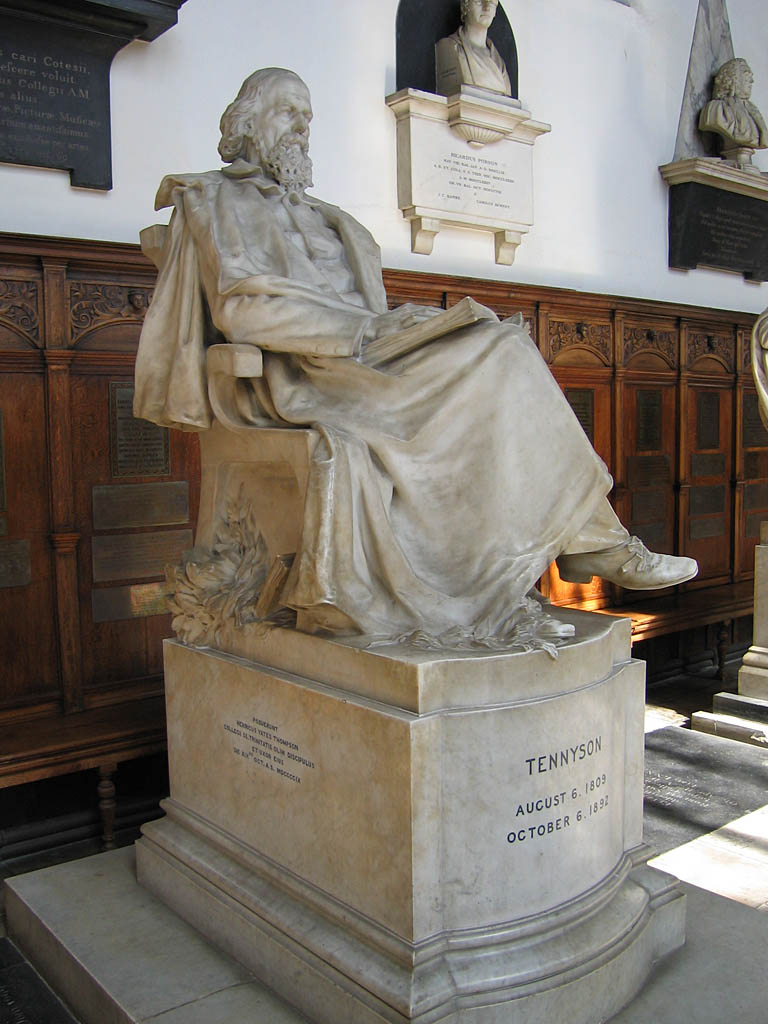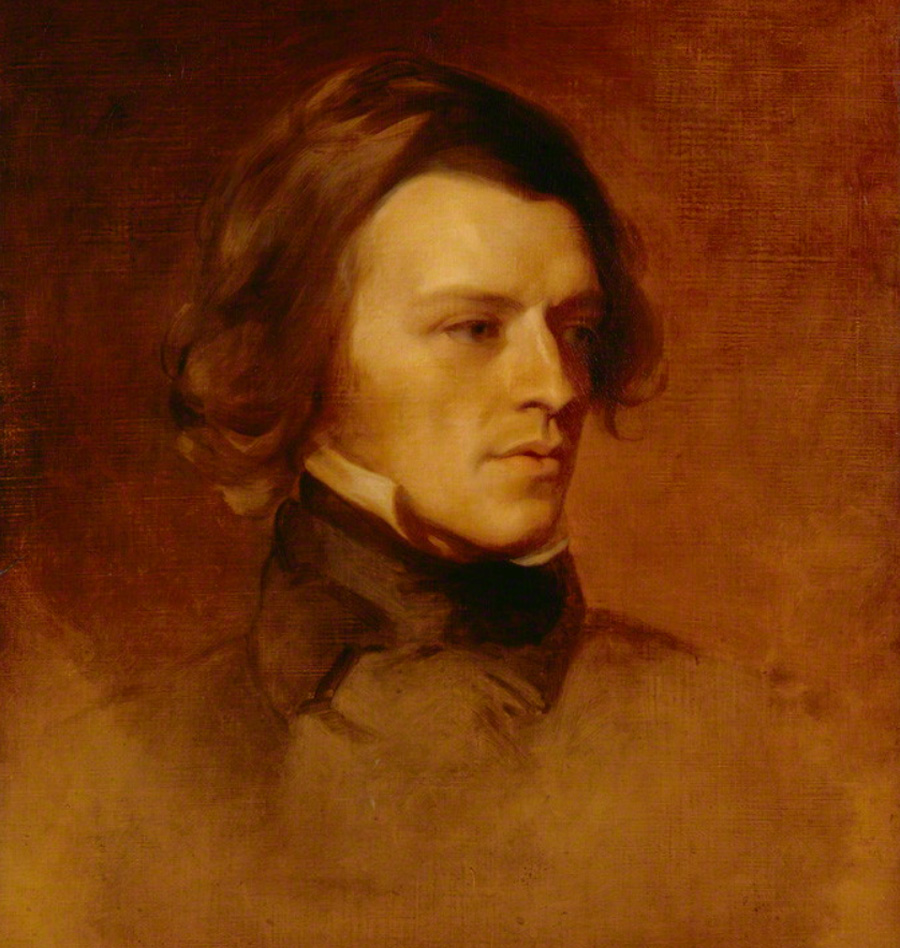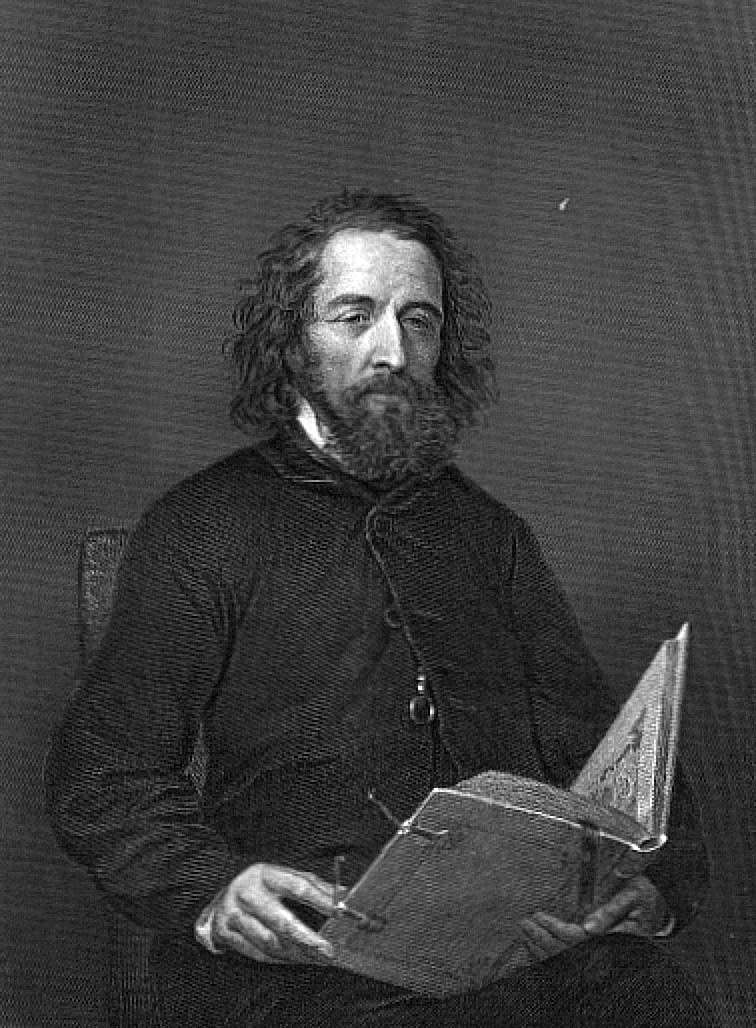|
Tennyson
Alfred Tennyson, 1st Baron Tennyson (; 6 August 1809 – 6 October 1892) was an English poet. He was the Poet Laureate of the United Kingdom, Poet Laureate during much of Queen Victoria's reign. In 1829, Tennyson was awarded the Chancellor's Gold Medal at Cambridge for one of his first pieces, "Timbuktu". He published his first solo collection of poems, ''Poems, Chiefly Lyrical'', in 1830. "Claribel (poem), Claribel" and "Mariana (poem), Mariana", which remain some of Tennyson's most celebrated poems, were included in this volume. Although described by some critics as overly sentimental, his poems ultimately proved popular and brought Tennyson to the attention of well-known writers of the day, including Samuel Taylor Coleridge. Tennyson's early poetry, with its medievalism and powerful visual imagery, was a major influence on the Pre-Raphaelite Brotherhood. Tennyson also focused on short lyrics, such as "Break, Break, Break", "The Charge of the Light Brigade (poem), The Charge ... [...More Info...] [...Related Items...] OR: [Wikipedia] [Google] [Baidu] |
Ulysses (poem)
"Ulysses" is a poem in blank verse by the Victorian era, Victorian poet Alfred, Lord Tennyson (1809–1892), written in 1833 and published in 1842 in his well-received Poems (Tennyson, 1842), second volume of poetry. An oft-quoted poem, it is a popular example of the dramatic monologue. Facing old age, mythical hero Odysseus, Ulysses describes his discontent and restlessness upon returning to his kingdom, Homer's Ithaca, Ithaca, after his far-ranging travels. Despite his reunion with his wife Penelope and his son Telemachus, Ulysses yearns to explore again. The Ulysses character (in Greek language, Greek, Odysseus) has been widely examined in literature. His adventures were first recorded in Homer's ''Iliad'' and ''Odyssey'' (c. 800–700 BC), and Tennyson draws on Homer's narrative in the poem. Most critics, however, find that Tennyson's Ulysses recalls Dante Alighieri, Dante's Ulisse in his ''The Divine Comedy#Inferno, Inferno'' (c. 1320). In Dante's re-telling, Ulisse is conde ... [...More Info...] [...Related Items...] OR: [Wikipedia] [Google] [Baidu] |
Hallam Tennyson, 2nd Baron Tennyson
Hallam Tennyson, 2nd Baron Tennyson, (11 August 1852 – 2 December 1928) was a British aristocrat who served as the second governor-general of Australia, in office from 1903 to 1904. He was previously Governor of South Australia from 1899 to 1902. Tennyson was born in Twickenham, Middlesex, and educated at Marlborough College and Trinity College, Cambridge. He was the eldest son of the poet Alfred, Lord Tennyson, and served as his personal secretary and biographer; he succeeded to his father's title in 1892. Tennyson was made Governor of South Australia in 1899. When Lord Hopetoun resigned the governor-generalship in mid-1902, Tennyson was the longest-serving state governor and thus became Administrator of the Government. Tennyson was eventually chosen to be Hopetoun's permanent replacement, but accepted only a one-year term. He was more popular than his predecessor among the general public, but had a tense relationship with Prime Minister Alfred Deakin and was not offered a ... [...More Info...] [...Related Items...] OR: [Wikipedia] [Google] [Baidu] |
Mariana (poem)
"Mariana" is a poem by Alfred, Lord Tennyson, published in 1830. The poem follows a common theme in much of Tennyson's work—that of despondent isolation. The subject of "Mariana" is a woman who continuously laments her lack of connection with society. The isolation defines her existence, and her longing for a connection leaves her wishing for death at the end of every stanza. The premise of "Mariana" originates in William Shakespeare's ''Measure for Measure'', but the poem ends before Mariana's lover returns. Tennyson's version was adapted by others, including John Everett Millais and Elizabeth Gaskell, for use in their own works. The poem was well received by critics, and it is described by critics as an example of Tennyson's skill at poetry. Tennyson wrote "Mariana" in 1830 and printed it within his early collection '' Poems, Chiefly Lyrical''. Previously, he contributed poems to the work ''Poems by Two Brothers'' (1827), where his early poems dealing with isolation and memo ... [...More Info...] [...Related Items...] OR: [Wikipedia] [Google] [Baidu] |
Arthur Hallam
Arthur Henry Hallam (1 February 1811 – 15 September 1833) was an English poet, best known as the subject of a major work, '' In Memoriam'', by his close friend and fellow poet Alfred Tennyson. Hallam has been described as the ''jeune homme fatal'' (French for "deadly eductiveyoung man") of his generation. Early life and education Hallam was born in London, the son of the historian Henry Hallam. He attended school at Eton, where he met the future prime minister, William Ewart Gladstone. Hallam was an important influence on Gladstone, introducing him to Whiggish ideas and people. Other friends included James Milnes Gaskell. After leaving Eton in 1827 Hallam travelled on the continent with his family, and in Italy, he became inspired by its culture and fell in love with an English beauty, Anna Mildred Wintour, who inspired eleven of his poems. In October 1828, Hallam went up to Trinity College, Cambridge, where he met and befriended Tennyson. As Christopher Ricks observes, ... [...More Info...] [...Related Items...] OR: [Wikipedia] [Google] [Baidu] |
Emily Sellwood
Emily Sarah Tennyson, Baroness Tennyson ( Sellwood; 9 July 1813 – 10 August 1896), known as Emily, Lady Tennyson, was the wife of the poet Alfred, Lord Tennyson, and an author and composer in her own right. Emily was the oldest of three daughters, raised by a single father, after her mother Sarah died when she was three years old. Her father, a successful lawyer, was devoted to her and her sisters and ensured that they had a good education. She met Alfred when she was a girl, but they did not develop a romantic relationship until his brother Charles married her sister Louisa. It was thirteen years before they would marry, due to her father's concerns about the degree to which Tennyson could provide for her on a poet's salary. When his career became more successful, Emily and Alfred married. Emily played a number of significant roles in Alfred's life. Aside from being a wife and mother of two sons, she ran large households and conducted business tasks for her husband. She p ... [...More Info...] [...Related Items...] OR: [Wikipedia] [Google] [Baidu] |
Idylls Of The King
''Idylls of the King'', published between 1859 and 1885, is a cycle of twelve narrative poems by the English poet Alfred, Lord Tennyson (1809–1892; Poet Laureate from 1850) which retells the legend of King Arthur, his knights, his love for Guinevere and her tragic betrayal of him, and the rise and fall of Arthur's kingdom. The whole work recounts Arthur's attempt and failure to lift up mankind and create a perfect kingdom, from his coming to power to his death at the hands of the traitor Mordred. Individual poems detail the deeds of various knights, including Lancelot, Geraint, Galahad, and Balin and Balan, and also Merlin and the Lady of the Lake. There is little transition between Idylls, but the central figure of Arthur links all the stories. The poems were dedicated to the late Albert, Prince Consort. The ''Idylls'' are written in blank verse. Tennyson's descriptions of nature are derived from observations of his own surroundings, collected over the course of ... [...More Info...] [...Related Items...] OR: [Wikipedia] [Google] [Baidu] |
The Lotos-Eaters
''The Lotos-Eaters'' is a poem by Alfred, Lord Tennyson, Alfred Tennyson, 1st Baron Tennyson, published in Tennyson's 1832 poetry collection. It was inspired by his trip to Spain with his close friend Arthur Hallam, where they visited the Pyrenees mountains. The poem describes a group of mariners who, upon eating the Lotus tree, lotos, are put into an Altered state of consciousness, altered state and isolated from the outside world. The title and concept derives from the lotus-eaters in Greek mythology. Background In summer 1829, Tennyson and Arthur Hallam made a trek into conflict-torn northern Spain. The scenery and experience influenced a few of his poems, including ''Oenone (poem), Oenone'', ''The Lotos-Eaters'' and ''wikisource:Mariana in the South, Mariana in the South''. These three poems, and some others, were later revised for Tennyson's Poems (Tennyson, 1842), 1842 collection. In this revision Tennyson takes the opportunity to rewrite a section of ''The Lotos-Eaters'' ... [...More Info...] [...Related Items...] OR: [Wikipedia] [Google] [Baidu] |
The Charge Of The Light Brigade (poem)
"The Charge of the Light Brigade" is an 1854 narrative poem by Alfred, Lord Tennyson about the Charge of the Light Brigade, cavalry charge of the same name at the Battle of Balaclava during the Crimean War. He wrote the original version on 2 December 1854, and it was published on 9 December 1854 in ''The Examiner (1808–1886), The Examiner''. He was the Poet Laureate of the United Kingdom at the time. The poem was subsequently revised and expanded for inclusion in ''Maud and other poems, Maud and Other Poems'' (1855). History Composition During 1854, when the United Kingdom was engaged in the Crimean War, Tennyson wrote several patriotic poems under various pseudonyms. Scholars speculate that Tennyson created his pen names because these verses used a traditional structure Tennyson employed in his earlier career but suppressed during the 1840s, worrying that poems like "The Charge of the Light Brigade" (which he initially signed only A.T.) "might prove not to be decorous for a p ... [...More Info...] [...Related Items...] OR: [Wikipedia] [Google] [Baidu] |
Tears, Idle Tears
"Tears, Idle Tears" is a lyric poem written in 1847 by Alfred, Lord Tennyson (1809–1892), the Victorian-era English poet. Published as one of the "songs" in his '' The Princess'' (1847), it is regarded for the quality of its lyrics. A Tennyson anthology describes the poem as "one of the most Virgilian of Tennyson's poems and perhaps his most famous lyric".Hill (1971), p. 114. Readers often overlook the poem's blank verseHough, Graham (1951), p. 187. "'Tears, Idle Tears'." In Killham (1960), pp. 186–191.—the poem does not rhyme. Analysis Tennyson was inspired to write "Tears, Idle Tears" upon a visit to Tintern Abbey in Monmouthshire, an abbey that was abandoned in 1536. He said the convent was "full for me of its bygone memories", and that the poem was about "the passion of the past, the abiding in the transient." William Wordsworth also wrote a poem inspired by this location in 1798, " Tintern Abbey", which develops a similar theme. While Tintern Abbey may have prom ... [...More Info...] [...Related Items...] OR: [Wikipedia] [Google] [Baidu] |
Break, Break, Break
"Break, Break, Break" is a poem by Alfred, Lord Tennyson written during early 1835 and published in 1842. The poem is an elegy that describes Tennyson's feelings of loss after Arthur Henry Hallam died and his feelings of isolation while at Mablethorpe, Lincolnshire. Themes The poem describes feelings of loss, spoken by a man standing on the rocky sea shore. It has a strong biographical connection, containing Tennyson's feelings of melancholy and nostalgia. Tennyson captures his strong emotions in other poems, including ''Morte D' Arthur'', "Tithonus", and " Ulysses". The suffering felt within the poem is connected to the suffering described in Tennyson's ''In Memoriam'', in that they both describe longing for Tennyson's deceased friend Hallam. This longing is voiced in the third stanza of "Break, Break, Break". "Break, Break, Break" can be classified as an elegy on the subject of Tennyson's feelings about Hallam. Like " On a Mourner," written a year before, both poems use a very ... [...More Info...] [...Related Items...] OR: [Wikipedia] [Google] [Baidu] |
Somersby, Lincolnshire
Somersby is a village in the civil parish of Greetham with Somersby, in the East Lindsey district of Lincolnshire, England. It is situated north-west from Spilsby and east-north-east from Horncastle. The village lies in the Lincolnshire Wolds The Lincolnshire Wolds which also includes the Lincolnshire Wolds National Landscape are a range of low hills in the county of Lincolnshire, England which runs roughly parallel with the North Sea coast, from the Humber Estuary just west of the t ..., a designated Area of Outstanding Natural Beauty; the parish covers about . In 1971 the parish had a population of 119. On 1 April 1987 the parish was abolished and merged with Greetham, Lincolnshire, Greetham to form "Greetham with Somersby". Tennyson Alfred, Lord Tennyson, Poet Laureate, was born and brought up in Somersby, the son of the rector (ecclesiastical), rector, and the fourth of twelve children. When he wrote ''The Babbling Brook'' he was referring to a small stream here. ... [...More Info...] [...Related Items...] OR: [Wikipedia] [Google] [Baidu] |
Poems, Chiefly Lyrical
''Poems, Chiefly Lyrical'' is a poetry collection by Alfred Tennyson, published in June 1830. Contents The poems are fifty-six in number: Of these the poems in ''italics'' appeared in the edition of 1842, and were not much altered. Those with an asterisk were, in addition to the italicised poems, afterwards included among the ''Juvenilia'' in the collected works (1871–1872), though excluded from all preceding editions of the poems. Those with both a dagger and an asterisk were restored in editions previous to the first collected editions of the works. History ''Poems, Chiefly Lyrical'', was published in 1830 by Effingham Wilson, also the publisher of Robert Browning's ''Paracelsus''. The volume had the following title-page: ''Poems, Chiefly Lyrical, by Alfred Tennyson''. London: Effingham Wilson, Royal Exchange, 1830.Collins 1900, p. vii. Favourable reviews appeared by Sir John Bowring in the ''Westminster'', by Leigh Hunt in the ''Tatler'', and by Arthur Hallam in the '' ... [...More Info...] [...Related Items...] OR: [Wikipedia] [Google] [Baidu] |








